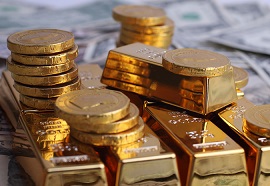Forbes: Central Banks Go On Gold Buying Spree Over Dollar Worries

Article by Simon Constable on Forbes
The world's central banks are on a gold buying spree that has lasted more than a decade. That's the longest period of consistent gold acquisition by the so-called official sector in more than half a century.
But this time the motivations of the buyers are different than they were back in the 1950s, and they are worrying. That's why investors should take note.
In the distant past, central banks had to buy gold because of its vital role in the global financial system. Now they are choosing to do so because they are worried about the dollar. In other words, they've been scared into this bullion buying binge.
Here's the detail.
Long gone historical role
Before the gold standard monetary system was abandoned in 1971, central banks, such as the Federal Reserve or the Bank of England, had to buy and sell gold. Doing so was an essential part of the global financial system that was set up in the closing days of WWII, the so-called Bretton Woods system. As international trade flourished so the need for gold increased. That's why central banks added a lot of bullion to their reserves in the 1950s and 1960s.
Over the 16 years through 1965, the world's central banks added at least 5 million troy ounces of bullion to their gold stash each and every year. Some years the additions were higher than 20 million ounces, according to data from New York-based commodities consulting company CPM Group.
That 16-year period may understate the prolonged central bank demand for bullion reserves. Jeff Christian, managing partner of CPM Group, explains:
“It was a continuation of a longer-term trend because of gold’s role in currency systems, its use as a denominator for the value of national currencies at the time, and its use in settling international trade settlements.”
Nixon nixes gold
Eventually, this gold-based system died. Officially, U.S. President Richard Nixon nixed it in 1971 when he stopped countries from exchanging dollars for gold. The period of the late 1960s also coincided with massive military spending by the U.S. due to the country's entanglement in Vietnam.
Unofficially, the end of gold's vital role in trade came in 1966 as individuals started to demand gold in exchange for their dollars, says Christian. Eventually, they were shut out just as the countries were excluded.
Over the period of 1966 through 2007 central banks mainly ditched their gold holdings. That is to say, they sold right up until the global financial crisis really hit home in 2008.
Crisis boosts central bank demand
As the global financial system ceased up in 2008 and early 2009, global central banks caught the gold buying bug again. It's a trend that looks likely to continue.
Starting in 2008 central banks have continuously added gold to their reserves. At first, the net acquisitions additions were relatively small. In 2008 and 2009, such institutions added 580,000 and 210,000 ounces of the metal respectively, again according to CPM data. Since then the buying binge has accelerated, with around 11 million ounces getting purchased in 2017, with likely a similar amount forecast for this year.
Russia leads the pack
"Today central banks are buying gold to diversify their monetary reserves," says CPM's Christian. "Most central banks want to diversify away from the dollar."
Most see their gold holdings in a similar way to investors. That is, it makes up a small value of total assets but also acts as a useful diversifier of risk, he says. However, other countries are going further. Christian explains:
“Russia and Kazakhstan primarily, and a few other former CIS [the Commonwealth of Independent States that were part of the Soviet Union] nations see it playing a bigger role.”
For countries, such as Russia, the change may be partly driven by the idealistic need to ditch dollars and unentangle their countries from the U.S. banking system.
Every year starting in 2005 Russia added to its gold reserves. It has also been the biggest driver in the trend of central banks adding to overall holdings of the metal. For instance, in 2017 Russia's gold buying activities accounted for two-thirds of the total 10.95 million ounces of net gold buying by central banks during the year. Kazakstan, the next closest behind Russia, took 12.6% of the total (1.38 million.)
Meanwhile, this year Russia's central bank bought another 3.381 million ounces in the year through June, according to CPM's Christain. And Turkey bought 1.223 million ounces over the same period, he says.
Relations between Russia and the U.S. have broken down lately. Similar is true of the relationship between Turkey and the western powers.
The trend will continue
It is entirely possible that the central bank buying binge will continue apace, according to an August-dated report from ETF Securities (U.S.) LLC.
The research notes that central banks have remained solid buyers of the metal despite soft demand from investors and high levels of bets for a price decline in the futures market.
Of course, it could be that central bankers are buyers when prices are relatively weak, which also tends to coincide with periods when investment demand is soft.
Whatever, the reason, it would seem that things are different now than they were over the decades from 1966 through 2007. Now when bullion prices are slipping, it might be reasonable to assume that at least some central banks will enter the gold market with orders to buy. That's quite a turnaround from 20 years ago when consistent selling was the rage in the official sector.
To read this article on Forbes website, click here